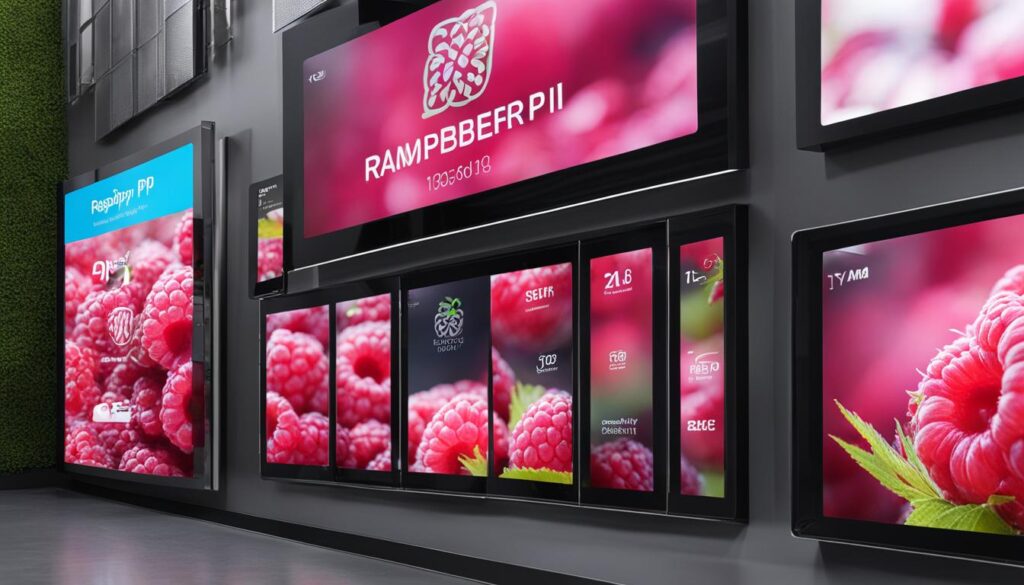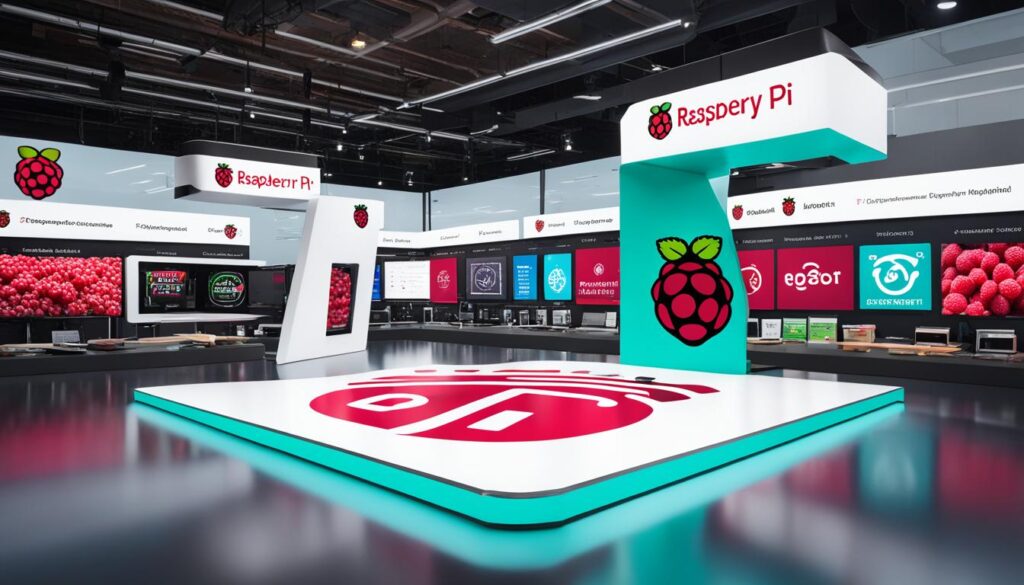Raspberry Pi is a popular and cost-effective hardware platform for digital signage. There are several software options available that are specifically designed to work with Raspberry Pi and provide a complete solution for creating engaging displays. These software options offer features such as content management, offline playback, customization, and remote management.
Businesses and DIY enthusiasts can easily set up and use these software solutions to create professional digital signage displays using Raspberry Pi.

Key Takeaways:
- Digital signage software for Raspberry Pi offers a cost-effective solution for creating engaging displays.
- Features such as content management, offline playback, and customization make Raspberry Pi digital signage software a versatile choice.
- Raspberry Pi digital signage is easy to set up and use, making it suitable for beginners.
- Various industries and applications benefit from using Raspberry Pi digital signage, including video distribution, in-store promotion, and corporate communication.
- Raspberry Pi digital signage offers benefits such as cost savings, customizability, reliability, and smooth content playback.
Features of Raspberry Pi Digital Signage Software
Raspberry Pi digital signage software offers a range of features that make it an ideal choice for creating digital displays. These features include:
- The ability to use familiar content creation tools
- Flexibility in sourcing content
- Offline working and fast sync
- Media specific players for smooth video playback
- A complete solution with built-in layouts, ticker, adverts insertion, campaign scheduling, and more
With these features, Raspberry Pi digital signage software provides a comprehensive platform for businesses and individuals looking to showcase their content on digital displays.
“The flexibility and range of features offered by Raspberry Pi digital signage software have made it an invaluable tool for organizations and system integrators across industries. Its ability to support familiar content creation tools and provide media-specific players ensure smooth and seamless playback of videos and other media content.”
Raspberry Pi’s digital signage software has gained popularity due to its reliability, versatility, and user-friendly interface. It caters to the diverse needs of businesses and individuals looking to create engaging displays in various settings.

Getting Started with Raspberry Pi Digital Signage Software
If you’re ready to dive into the world of digital signage using Raspberry Pi, getting started is easier than you might think. Follow these simple steps to set up your Raspberry Pi signage player and begin creating captivating displays.
Step 1: Assemble Your Raspberry Pi Kit
Start by assembling your Raspberry Pi kit. Ensure you have all the necessary components, including the Raspberry Pi device, an SD card, a power supply, and any cables required for connecting to a screen.
Step 2: Prepare the SD Card
Next, prepare the SD card by installing the piSignage image. This image contains the necessary software to run your digital signage system on Raspberry Pi. Follow the instructions provided with your kit to complete this step.
Step 3: Sign Up and Register Your Player
Once you have your hardware set up, it’s time to sign up for a free account at pisignage.com. Register your player by following the prompts and providing the required information. This registration will connect your Raspberry Pi to the piSignage server, enabling you to manage your digital signage content.
Step 4: Upload Content and Create Playlists
With your player registered, you can now start uploading your content to the piSignage platform. This could include images, videos, animations, or any other media you want to display. Create playlists to organize and schedule your content for a seamless flow of information on your digital signage displays.
Step 5: Deploy to Your Group of Players
Once your content and playlists are ready, it’s time to deploy them to your group of players. Whether you have one Raspberry Pi or multiple devices, piSignage makes it easy to manage and synchronize your displays. Your digital signage will be up and running in no time.
“Getting started with Raspberry Pi digital signage is a breeze. With the user-friendly piSignage platform and the flexibility of Raspberry Pi hardware, even beginners can quickly set up and manage captivating displays.”- Amanda Rodriguez, Digital Signage Enthusiast
Troubleshooting and Support
If you encounter any issues during the setup process, don’t worry! piSignage offers comprehensive step-by-step instructions and an active support community to help you along the way. Whether you’re facing technical difficulties or seeking creative inspiration, you’ll find the assistance you need to make the most of your Raspberry Pi digital signage software.
Use Cases for Raspberry Pi Digital Signage
Raspberry Pi digital signage is a versatile solution that finds application in various industries and settings. Take a look at some of the common use cases where Raspberry Pi is employed for creating impactful displays:
- Video Distribution: Raspberry Pi digital signage enables businesses to distribute videos efficiently, allowing them to engage their audience effectively.
- In-Store Promotion: Retailers can utilize Raspberry Pi to display promotions, advertisements, and product information, enhancing the shopping experience for customers.
- Campus Information Screens: Educational institutions can utilize Raspberry Pi to showcase essential information, event schedules, and announcements throughout the campus.
- Corporate Communication: Raspberry Pi facilitates internal communication within a corporation, displaying news, updates, and messages to employees in real-time.
- Digital Displays and Menus: Raspberry Pi digital signage transforms traditional menus and static displays into dynamic, engaging content, attracting customers and increasing sales.
- Dashboards and Streaming: Raspberry Pi can be used to display real-time data, including analytics, social media feeds, and live streaming, making it an ideal choice for creating interactive dashboards.
These applications highlight the flexibility and effectiveness of Raspberry Pi digital signage in communicating messages, promoting products and services, and providing real-time information. With its affordability and versatility, Raspberry Pi is a suitable choice for businesses across different industries seeking to enhance their visual communication strategies.
Benefits of Raspberry Pi Digital Signage
Raspberry Pi digital signage offers several benefits for businesses and DIY enthusiasts. Whether you’re a small business owner or a tech-savvy hobbyist, Raspberry Pi digital signage provides a cost-effective solution that can enhance your visual communication strategies. Let’s explore some of the key advantages:
1. Cost-effectiveness
Raspberry Pi digital signage significantly reduces hardware costs by up to 35% compared to other options. This affordability makes it an attractive choice for businesses with budget constraints or individuals looking for a cost-effective digital display solution.
2. Customizability
With Raspberry Pi, you have the freedom to customize your digital displays to align with your brand and convey your desired message. Whether it’s adding your logo, changing colors, or creating unique layouts, you have complete control over the visual aesthetics of your signage. This level of customization helps you create impactful displays that resonate with your target audience.
3. Reliability and Security
Raspberry Pi is renowned for its reliability and security features. As a robust single-board computer, it can handle continuous operation without experiencing performance issues. Additionally, Raspberry Pi’s built-in security protocols protect your digital displays from unauthorized access, ensuring the integrity of your content.
4. Accessibility
Raspberry Pi digital signage is designed to be accessible to users of all skill levels. Its user-friendly interface and intuitive setup process make it easy for beginners to get started. Whether you’re a tech enthusiast or a business owner with limited technical knowledge, Raspberry Pi signage player offers a hassle-free experience.
5. Smooth Content Playback
One of the highlights of Raspberry Pi digital signage is its ability to deliver smooth content playback. With dedicated media-specific players, Raspberry Pi ensures high-quality video playback, making your digital displays visually appealing and engaging for your audience.
6. Scalability
Whether you have a single display or a network of digital signage screens, Raspberry Pi offers seamless scalability. You can effortlessly expand your signage network by adding more Raspberry Pi devices, allowing you to reach a wider audience and increase your brand exposure.
7. Energy Efficiency
Raspberry Pi’s energy-efficient design helps reduce power consumption, making it an eco-friendly choice for digital signage solutions. This advantage not only benefits the environment but also helps lower your electricity bills, contributing to overall cost savings.
8. Easy Content Updates
Updating content on your Raspberry Pi digital displays is a breeze. Whether you want to change promotional offers, update event schedules, or display real-time information, Raspberry Pi allows for quick and easy content updates. This flexibility ensures that your digital displays remain relevant and up to date.
With these compelling benefits, it’s no wonder that Raspberry Pi digital signage has gained popularity among businesses and DIY enthusiasts alike. This versatile platform empowers you to create impactful visual displays that captivate your audience, communicate your message effectively, and enhance your brand presence.

| Benefits | Summary |
|---|---|
| Cost-effectiveness | Reduces hardware costs by up to 35% |
| Customizability | Allows for personalized branding and message |
| Reliability and Security | Provides robust performance and built-in security |
| Accessibility | Easy setup and user-friendly interface |
| Smooth Content Playback | Dedicated media-specific players for high-quality video playback |
| Scalability | Effortless expansion of signage network |
| Energy Efficiency | Reduces power consumption and lowers electricity bills |
| Easy Content Updates | Quick and hassle-free updating of content |
Setting up Raspberry Pi for Digital Signage
Setting up Raspberry Pi for digital signage is a simple process, making it accessible for beginners and experienced users alike. When you purchase a Raspberry Pi kit, it typically includes all the necessary components: the device itself, a memory card, a power supply, and sometimes a cable for connecting to a screen.
Once you have assembled the hardware, the next step is to prepare the memory card. The memory card usually comes pre-loaded with the necessary operating system for Raspberry Pi, which streamlines the setup process and eliminates the need for manual installation.
After setting up the hardware and preparing the memory card, you can easily connect your Raspberry Pi to the digital signage system. Raspberry Pi offers a user-friendly interface, allowing you to navigate and configure the necessary settings effortlessly.
Once you are connected, you can start playing your content on the digital display. Whether it’s advertisements, informational content, or interactive media, Raspberry Pi provides a seamless experience for showcasing your digital signage.
Raspberry Pi also offers extensive support resources, including online communities and documentation, to assist you throughout the setup and management process. With these resources at your disposal, you can troubleshoot any issues that may arise and optimize your digital signage display.
Setting up Raspberry Pi for digital signage is a hassle-free experience, thanks to its intuitive interface, comprehensive support, and all-inclusive hardware kits. With Raspberry Pi, you can unleash the full potential of digital displays and create captivating advertisements, informative screens, and interactive experiences.
Conclusion
Raspberry Pi digital signage software is the perfect solution for businesses and DIY enthusiasts who want to create captivating displays without breaking the bank. With its affordable price tag and versatility, Raspberry Pi is quickly becoming a popular choice in the digital signage industry.
One of the key advantages of using Raspberry Pi for digital signage is its user-friendly interface. Setting up and managing your displays is a breeze, even for beginners. Additionally, the software offers a wide range of features such as remote content management, customization options, and smooth playback, ensuring that your message is delivered flawlessly to your audience.
Whether you’re looking to distribute videos, promote products in-store, or communicate important information within your organization, Raspberry Pi digital signage has got you covered. Its compatibility with Raspberry Pi hardware and ability to run a variety of content make it a versatile tool that can be adapted to suit almost any industry or use case.
In conclusion, Raspberry Pi digital signage software is a cost-effective, reliable, and powerful solution for creating impactful displays. With its ease of use, extensive features, and compatibility with Raspberry Pi, it is the go-to choice for anyone looking to enhance their brand, engage their audience, and deliver a visually stunning message.
FAQ
What is Raspberry Pi digital signage software?
Raspberry Pi digital signage software is a software solution specifically designed to work with Raspberry Pi hardware. It provides a complete solution for creating engaging displays and offers features such as content management, offline playback, customization, and remote management.
What are the features of Raspberry Pi digital signage software?
The features of Raspberry Pi digital signage software include the ability to use familiar content creation tools, flexibility in sourcing content, offline working and fast sync, media-specific players for smooth video playback, and a complete solution with built-in layouts, ticker, adverts insertion, campaign scheduling, and more.
How do I get started with Raspberry Pi digital signage software?
To get started with Raspberry Pi digital signage software, you need to assemble the Raspberry Pi kit and prepare the SD card with the piSignage image. Then, sign up for a free account at pisignage.com and register your player. You can upload your content, create playlists, and deploy them to your group of players with step-by-step instructions and support available.
What are the use cases for Raspberry Pi digital signage?
Raspberry Pi digital signage is used in various applications and industries, including video distribution, in-store promotion, campus information screens, corporate communication, digital displays and menus, and dashboards and streaming. It allows businesses to effectively communicate with their audience, promote products and services, display real-time information, and enhance the overall customer experience.
What are the benefits of Raspberry Pi digital signage?
Raspberry Pi digital signage offers several benefits, including cost-effectiveness, customization, reliability, security, accessibility, smooth content playback, scalability, energy efficiency, and easy content updates. It is a compelling choice for visual communication and suitable for businesses of all sizes.
How do I set up Raspberry Pi for digital signage?
Setting up Raspberry Pi for digital signage is straightforward. Raspberry Pi kits usually come with all the necessary components, including the device itself, a memory card, a power supply, and sometimes a cable for connecting to a screen. The memory card usually comes pre-loaded with the necessary operating system, making the setup process easier. Once the hardware is set up, users can easily connect to their digital signage system and start playing their content.